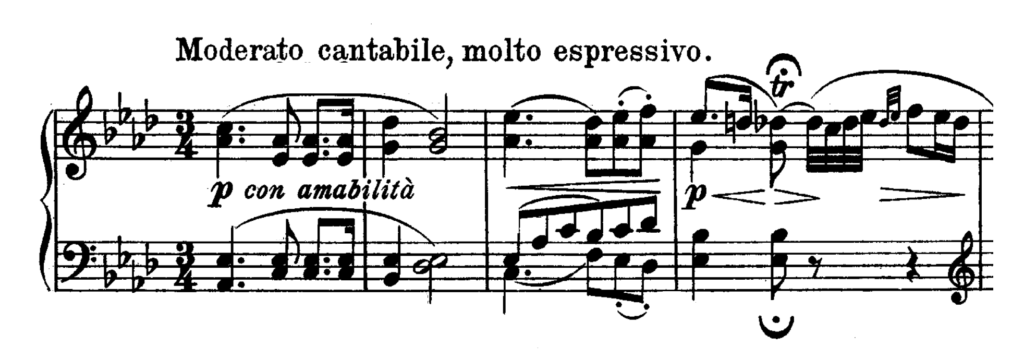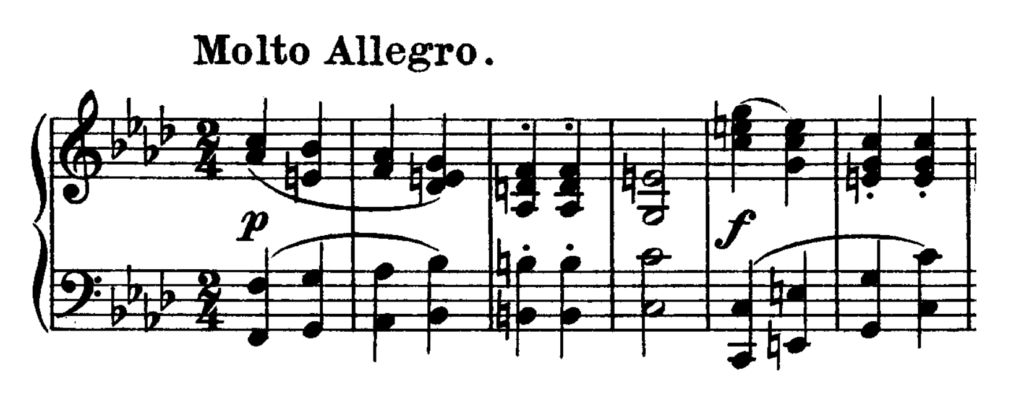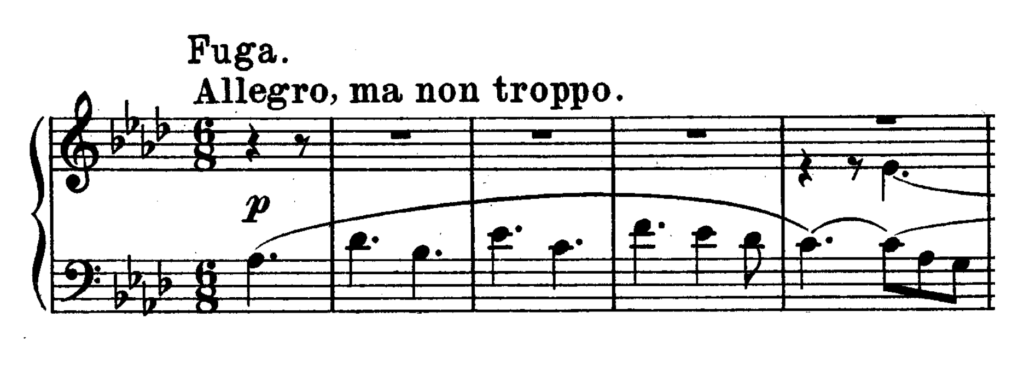Analysis
Contents
For the benefit of all pianists learning this work, we present to you a concise and easy to use analysis of Beethoven’s Piano Sonata No.31 in Ab Major Op. 110
First Movement (Moderato Cantabile Molto Espressivo)
Form: Sonata Form. Ab Major.
EXPOSITION:
Bars 1-12: First Subject in A flat major (tonic). The first subject may be divided into two parts: the first part, Bars 1-4, ending on dominant seventh; the second part, consisting of a distinct melody of eight bars (Bars 5-12), ending with full close in tonic key.
Bars 12-28: Connecting Episode. The connecting episode begins with a brilliant arpeggio passage in tonic key, modulating to the dominant key, in which after a passage of different character, commencing Bar 20, it closes, Bar 28.
Bars 28-34: Second Subject in E flat major. The second subject consists of a passage of different character, extended to six bars. The bass of Bar 28 is repeated at Bar 29, and also (with one note altered) at Bar 30. It begins and ends in the dominant key.
Bars 34-38: Coda. A new figure is found at the commencement of the Coda, Bar 34, repeated slightly altered, Bar 35.
DEVELOPMENT:
Bars 38-56: The development, after two bars of introduction, is devoted to the first part of the first subject, commencing in the key of F minor (Bar 40).
RECAPITULATION:
Bars 56-70: First Subject in original key. The first subject re-appears, accompanied by a passage resembling that with which the connecting episode begins. The whole of the subject is considerably varied and elongated. The second part, instead of being in the key of the tonic, is, Bars 63-66, in the key of D flat major. At Bars 66-70 there is an enharmonic modulation (A flat to G sharp and D flat to C sharp) to E major.
Bars 70-87: Connecting Episode. The connecting episode begins in E major with the same passage as before; in fact, the whole of it is constructed from the same material, transposed so as to end in A flat major (tonic), Bar 87.
Bars 87-93: Second Subject in A flat major (tonic). The second subject re-appears, scarcely altered except harmonically, the key, of course, being changed to A flat major.
Bars 93-End: Coda. The Coda resembles that in the exposition at the beginning, after a passage of four bars, Bars 100-104, of a different character, the connecting episode is again referred to; it closes with tonic pedal point.
Second Movement (Molto Allegro)
Form: 3 Parts. F minor
FIRST PART (key of F minor):
Bars 1-42: The first part contains traces of Sonata form. The first subject consists of two phrases of four bars each, Bars 1-8, both ending in dominant major key. What might be called the development, Bars 9-29, begins with a sequential passage of eight bars (9-16), closing in A flat major (relative major), the rhythm being formed by inverting that of Bars 5-6. A new figure appears in the relative major, Bars 17-21, evidently taken from Bars 3-4. A reference to the first phrase, Bars 32-35, the accent being altered, is followed by the figure at Bar 17-18 in the tonic key, leading to the re-appearance of the first subject in tonic key, with different accent, as in the development, Bar 21. It is altered so as to end in the tonic.
SECOND PART (key of D flat major):
Bars 42-97: The second part is constructed upon a phrase of eight bars, Bars 42-50, ending in tonic key (D flat major). It is repeated with slight alterations,, Bars 50-58, ending in G flat major, in which key it appears, Bars 58-66, repeated, Bars 66-74, slightly altered, ending in E flat minor. Three bars, Bars 74-77, lead back to the tonic key (D flat major), followed immediately by the initial phrase, Bars 77-85, repeated an octave lower, Bars 85-93. Bars 94-97 lead to the repetition of Part I.
THIRD PART:
Bars 98-147: Repetition of First Part.
Bars 148-End: Coda. The Coda simply consists of a few chords in the tonic key (F minor), ending on major tonic chord.
Third Movement (Adagio Ma Non Troppo)
Form: Binary Form. Bb Minor.
Bars 1-7: Introduction. The introduction commences in B flat minor with a passage of three bars, modulating to a cadenza in A flat minor, soon afterwards by enharmonic change to another cadenza to E major, which is followed by a modulation to A flat minor, Bar 6, the key of the succeeding movement.
Bars 7-28: Although this movement (which commences at Bar 7) is in A flat minor (seven flats), the signature bears only six flats. This movement, preceded by the reiteration of the tonic chord, Bars 7-8, consists of a continuous melody, composed of four phrases of four bars each. The first phrase, Bars 9-12, commences in tonic key, and ends with half-close on the dominant, Bar 12. The second phrase, Bars 13-16, commences in the tonic key and ends in the relative major (C flat major). The third phrase, Bars 16-20, begins in C flat major, and ends with half-close on the dominant of A flat minor. The fourth phrase, Bars 20-24, begins and ends in A flat minor, it is followed by a Coda of two bars.
Fourth Movement (Allegro Ma Non Troppo)
Form: Rondo and Fugue. Ab Major.
See also Finale, Sonata No. 29.
FIRST PART:
Bars 1-89: First Subject in A flat major (tonic). The portion of this movement, which takes the place of the first subject, consists of a fugue in three parts, the subject of which is announced in the bass; it begins and ends in the tonic key, Bars 1-5. It is regularly answered in the fifth above, Bars 5-9 (counter subject in quavers (eighth notes)). After a short codetta the subject enters in the treble, Bars 11-15, followed by a short sequential episode formed upon the last four notes of the subject, ending in the dominant key, Bar 20. The answer appears again, Bars 20-24, the subject, Bars 28-32. An episode formed upon the counter-subject leads to the entry of the answer, Bars 37-41, followed by an episode, resembling that beginning Bar 15, modulating to C minor, in which key a reference to the subject appears in the bass, commencing at Bar 48. An episode upon a new subject begins at Bar 56. The subject enters in D flat major, Bars 62-66, answered, Bars 66-70. The subject appears next, Bars 76-80, partly answered (in stretto), Bar 78, and at Bar 80. The fugue ends upon dominant seventh, Bar 89.
Bars 89-111: Episode. This episode, with its short introduction (Bars 89-90), resembles the third movement, transposed a semitone lower into G minor. It is considerably altered, however, and shortened. It ends in G minor, Bar 106. The Coda in G major resembles that at the end of the third movement (extended).
Bars 111-127: First Subject in G major (inverted). The fugue subject re-appears here, in G major (inverted), Bar 11-115, answered, Bars 115-119. Development of it in this form continues till Bar 127.
SECOND PART:
Bars 127-149: Episode. There is nothing in this movement which takes the place of the second part usually found in Rondo for, unless the episode which begins Bar 127 can be looked upon as such. It is formed upon a new subject, Bar 127-128, in the bass, which is none other than the original subject in diminution. It is treated almost canonically, and with it is combined with the subject (augmented), Bars 127-135, also at Bars 135-143, ending in dominant key. The figure of the foregoing episode gives place to another variation of the original subject, Bar 143, which is developed till Bars 149. The inverted form of the subject appears at Bars 145-149.
THIRD PART:
Bars 149-175: First Subject in original key. The subject re-appears, Bars 149-153, in its original form and key, in octaves, with a new accompaniment, answered, Bars 153-157. A final entry of the subject, Bars 159-163, followed by a development of the last four notes, brings this part of the movement to a close in tonic key, Bar 175.
Bars 175-End: Coda. The Coda principally refers to the first subject upon tonic pedal point.










